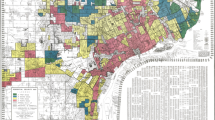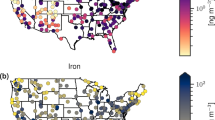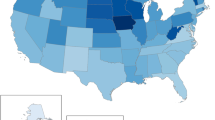Abstract
Data from the Massachusetts' Department of Environmental Protection (DEP) and the U.S. Census indicate that the toxic waste crisis is worsening. In addition to the contamination of deindustrialized urban areas comes increasing contamination in many newly industrialized suburbs. This results in both race and class biases with disproportionate amounts of toxic waste in urban communities of color and working-class (predominantly white) suburbs. Despite these “region-specific” associations, new evidence indicates that the single best indicator of toxic hazards, before controlling for region, is the percentage of community taxes from commercial and industrial sources. This raises important questions regarding sources of race and class biases and how to assess environmental injustices.
Similar content being viewed by others
REFERENCES
Anderton, Douglas 1994 “Hazardous waste facilities: 'Environmental equity' issues in metropolitan areas.” Evaluation Review 18:123-140.
Attah, E. B. 1992 “Demographics and siting issues in region IV.” In Bob Holmes (ed.), Proceedings of the Clark Atlanta University and EPA Region IV Conference on Environmental Equity.
Beckenbach, Frank 1989 “Social costs in modern capitalism.” Capitalism, Nature, Socialism, 1(3), Number 3.
Been, Vicki 1994 “Locally undesirable land uses in minority neighborhoods: Disproportionate siting or market dynamics?” Yale Law Journal 103:1383.
Bryant, Bunyan and Paul Mohai 1992 Race and the Incidence of Environmental Hazards: A Time for Discourse. Boulder, CO: Westview Press.
Bullard, Robert 1983 “Solid waste sites and the black community.” Sociological Inquiry 53:273-288.
Capek, Stella and John Gilderbloom 1992 “Community vs. Commodity: Tenants and the American City.” Albany, NY: State University of New York Press.
Claritas, Inc. 1992 See GAO, 1995.
Fisher, Michael 1995 “Environmental racism claims brought under Title VI of the Civil Rights Act.” Environmental Law Review 25:285-334.
Galster, George C. 1991 “Black suburbanization: Has it changed the relative location of races?” Urban Affairs Quarterly 26:621-628.
Gelobter, Michel 1992 “Toward a model of 'environmental discrimination.'” In Bryant and Mohai (eds.), Race and the Incidence of Environmental Hazards: A Time for Discourse: 64-81. Boulder, CO: Westview Press.
General Accounting Office 1983 “Siting of Hazardous Waste Landfills and Their Correlation with Racial and Economic Status of Surrounding Communities,” United States Government Printing Office, Washington, DC, 1983.
1995 “Hazardous and Non-Hazardous Waste: Demographics of People Living Near Waste Facilities,” United States Government Printing Office, Chapter Report, 6/13/95, GAO/RCED-95-84.
Goldman, Benjamin 1994 Toxic Wastes and Race Revisited: An Update of the 1987 Report on the Racial and Socioeconomic Characteristics of Communities with Hazardous Waste Sites. Washington, DC: Center for Policy Alternatives.
Gould, Jay M. 1986 Quality of Life in American Neighborhoods: Levels of Affluence, Toxic Waste, and Cancer Mortality in Residential Zip Code Areas. Boulder, CO: Westview Press.
Gould, Kenneth A. 1991 “The sweet smell of money: Economic dependency and local environmental political motivation.” Society and Natural Resources. 4:133.
Hird, John A. 1993 “Environmental policy and equity: The case of superfund.” Journal of Policy Analysis and Management 12:323.
Kapp, K. W. 1970 “Environmental disruption and social costs: A challenge to economics.” Kyklos: 23.
Kazis, Richard and Richard Grossman 1982 Fear at Work: Job Blackmail, Labor, and the Environment. New York: Pilgrim Press.
Krieg, Eric J. 1995 “A socio-historical interpretation of toxic waste sites: The case of greater Boston.” The American Journal of Economics and Sociology 54:1-14.
Lavelle, Marianne and Marcia Coyle 1992 “Unequal protection: The racial divide in environmental law.” The National Law Journal 15, Section S, p. 2.
Logan, John R. and Richard Alba 1993 “Locational returns to human capital: Minority access to suburban community resources.” Demography 30:243-268.
Logan, John R. and Harvey Molotch 1987 Urban Fortunes: The Political Economy of Place. Berkeley: University of California Press.
Massachusetts Department of Environmental Protection, Bureau of Waste Site Cleanup 1990 “List of contaminated sites and sites to be investigated.”
Medoff, Peter and Holly Sklar 1994 Streets of Hope: The Fall and Rise of an Urban Neighborhood. Boston, MA: South End Press.
Mohai, Paul and Bunyan Bryant 1992a “Environmental racism: Reviewing the evidence.” From Race and the Incidence of Environmental Hazards: A Time for Discourse: 163-176. Boulder, CO: Westview Press.
1992b “Race, poverty, and the environment; The disadvantaged face greater risks.” EPA Journal (March–April):6.
O'Connor, James 1994 “Is sustainable capitalism possible?” In Martin O'Connor (ed.), Is Capitalism Sustainable?: Political Economy and the Politics of Ecology. New York: The Guilford Press, pp. 152-175.
O'Connor, Martin 1994 Is Capitalism Sustainable?: Political Economy and the Politics of Ecology. New York: The Guilford Press.
Perfecto, Ivette 1992 “Farm workers, pesticides, and the international connection.” In P. Mohai and B. Bryant (eds.), Race and the Incidence of Environmental Hazards: A Time for Discourse. Boulder, CO: Westview Press, pp. 177-203.
Rosegrant, Susan and David Lampe 1992 Route 128. New York: Basic Books.
Ruben, Barbara and Joseph Smith 1994 “Jaundiced justice.” Environmental Action Magazine 26:21.
Schnaiberg, Allan and Kenneth A. Gould 1994 Environment and Society: The Enduring Conflict. New York: St. Martins.
Schneider, Mark and Thomas Phelan 1993 “Black suburbanization in the 1980s.” Demography 30:269-279.
Szasz, Andrew, Michael Meiser, Hal Aronson, and Hiroshi Fukurai 1993 “The demographics of proximity to toxic releases: The case of Los Angeles County.” Paper presented as the Meetings of the American Sociological Association, Miami, FL.
United Church of Christ, Commission for Racial Justice 1987 “Toxic wastes and race in the United States: A National Report on the Racial and Socio-Economic Characteristics of Communities with Hazardous Waste Sites”. New York: Commission for Racial Justice, United Church of Christ.
ViGYAN, Inc. 1992 See GAO, 1995.
Wernette, D. R. and L. A. Nieves 1992 “Breathing polluted air”. EPA Journal (March/April):16-17.
West, Patrick C., J. Mark Fly, Frances Larkin, and Robert W. Marans 1992 “Minority anglers and toxic fish consumption: Evidence from a statewide survey of Michigan.” In P. Mohai and B. Bryant (eds.), Race and the Incidence of Environmental Hazards: A Time for Discourse: 100-113. Boulder, CO: Westview Press.
White, Harvey L. 1992 “Hazardous waste incineration in minority communities.” In P. Mohai and B. Bryant (eds.), Race and the incidence of environmental hazards: A time for discourse: 126-139. Boulder, CO: Westview Press.
Zimmerman, Rae 1993 “Social equity as environmental risk.” Risk Analysis 13:649-666.
1994 See GAO, 1995.
Author information
Authors and Affiliations
Rights and permissions
About this article
Cite this article
Krieg, E.J. The Two Faces of Toxic Waste: Trends in the Spread of Environmental Hazards. Sociological Forum 13, 3–20 (1998). https://doi.org/10.1023/A:1022147712682
Issue Date:
DOI: https://doi.org/10.1023/A:1022147712682




